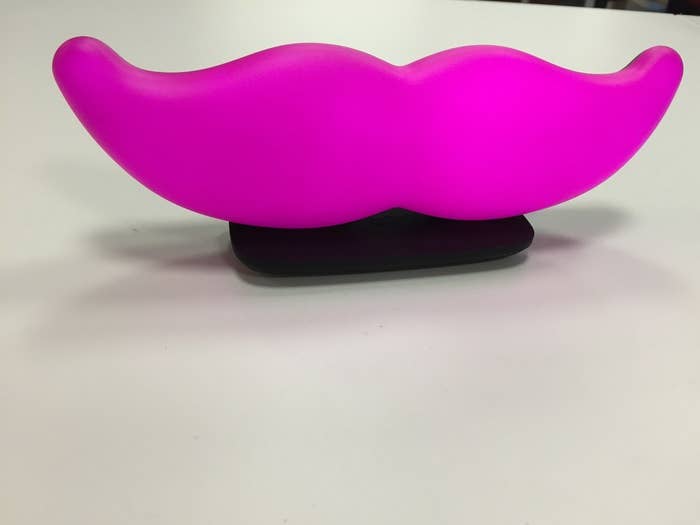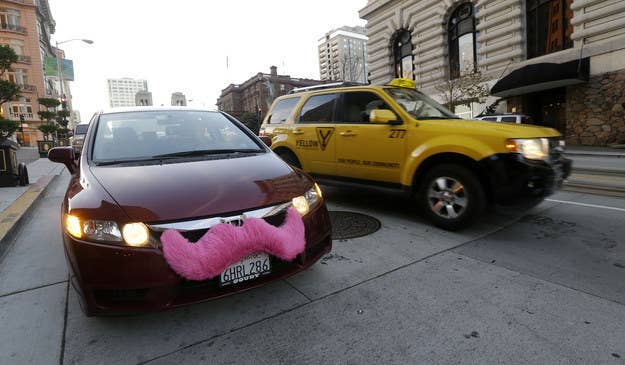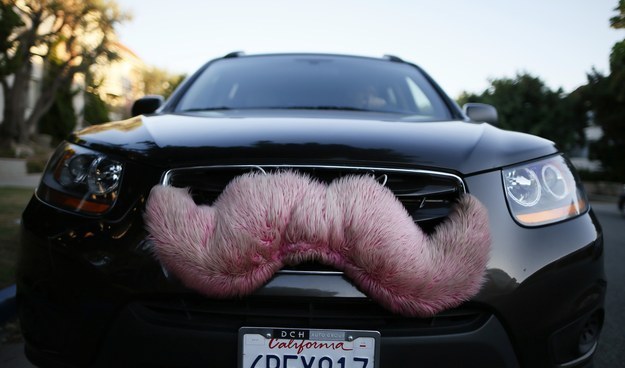
Chances are, if you've ever had a conversation about the ride-hailing service Lyft, you've heard it described in the context of Uber. It's not hard to understand why: The company popped up after Uber had made its inroads in numerous large American markets — and, by most measures, Lyft is still playing catch-up. Uber is in 54 countries and 165 cities in the United States, while Lyft is in 65 cities just in the U.S. Uber is valued at $40 billion and Lyft at just $1 billion.
Yet Lyft is also three years younger than Uber and has expanded rapidly. Tired of drafting behind, it's embarking on an ambitious new plan to pass the company it is often defined by, and it plans to do this by offering a better overall experience.
It's not entirely far-fetched. According to Lyft, it entered into 45 U.S. markets just last year and is now profitable in most of its cities. Lyft rides and revenue are also up five times year over year. And for a perennial runner-up, Lyft is impressively, if not somewhat irrationally, optimistic: In an interview with Katie Couric, co-founder and president John Zimmer said that Lyft will "absolutely" catch up with Uber. "We are growing faster than them in the United States," Zimmer told Couric.
To do that, Lyft will need to show consumers that it's different from Uber in some fundamental way. If it doesn't, consumers will continue to be faced with two basically similar products — except that one entered the market first and has consequently had more time to finesse its operations, troubleshoot its systems, and strike a working balance between the supply of drivers and demand of riders so neither are left wanting. In order to ultimately beat, or even catch up to the industry leader, Lyft has to be tangibly different, if not better. Yet the two things Lyft claims set it apart from Uber — its corporate culture and friendly ride experience — are difficult to scale on a national level particularly with a contract-based workforce.
If Lyft can't find a way to scale the "experience" nationwide, it'll be left with what's arguably just another version of Uber, with less market saturation and the addition of an in-app tipping feature. Companies that provide a service through independent contractors, rather than employees, may be inherently disadvantaged in this way. Scaling a company's culture and brand — both of which easily trickle down from the top when there's an ongoing interaction with the corporate environment — may not be feasible when there's a disconnect between the company and those who provide the service.
Which is not to say that it's impossible. Here's how Lyft plans to step on the gas.

At the executive level, Lyft and Uber are vastly different companies. Lyft co-founder Logan Green comes from a background in transportation: He created a car-share program on campus while a student at UC Santa Barbara, and also served on the transportation board in Santa Barbara. Zimmer, on the other hand, studied hospitality at Cornell's hotel school, where, Wampler told BuzzFeed News, he learned that 80% of seats in personal cars were empty. Combined, their respective backgrounds would come to form the foundation of Lyft's mission: to fill every seat in every car.
In 2007, the duo founded their first ride-share and carpool company, Zimride. It was sold to Enterprise in 2013.
Around the same time Zimmer and Green were building Zimride, Uber co-founder Travis Kalanick was selling his second not-so-successful tech startup, Red Swoosh, for $19 million after lead investor Mark Cuban backed out. Red Swoosh came in the aftermath of Kalanick's first failed startup attempt, Scour, which filed for bankruptcy in 2001.
But then in 2009, Kalanick and Uber co-founder Garret Camp (who also founded StumbleUpon and startup launching studio Expa) came up with the concept of Uber and its associated brand. It was, to put it mildly, a hit. But it also was far from Kalanick's original focus.
The differences in background, and perhaps culture, manifest in the companies' respective brands, Lyft Chief Marketing Officer Kira Wampler told BuzzFeed News.
"Uber is very much a delivery service," Wampler said. "They're efficient and are [pursuing] operational excellence and delivering a person or a thing from point A to B. It's much more Walmart-like in terms of experience and the participants in that system, particularly today, drivers — or, down the road, robots — but the participants in that system are all about being optimized and maximized for efficiency."
Lyft, on the other hand, is much more focused on the experience of the ride, Wampler said: "It's not just the destination, it's about enjoying the ride."
And according to Wampler, the companies are after two totally different markets. While Uber is continuing to work aggressively to capture the $11 billion taxi and limo market, Lyft is going after the $2.25 trillion personal transportation market. However, at the DLD Conference in Munich last month, Kalanick said he wanted to take 400,000 personal vehicles off the road: "This car replacement story is not just a vision or a dream," Kalanick said. "It's something that is actually taking place today."
Both companies offer ride-share services that are working to this larger goal of car replacement. Both also have carpool services: Lyft has Lyft Line, Uber has Uber Pool. And the services of each are similarly priced in most markets — and are roughly half the price of taxis. But it's not enough to simply have the technology that offer these services Wampler said. It needs to have humanity.
"If [the technology] lacks the willingness of people to connect with each other and the willingness for people to sit in the front seat at least occasionally, then you can't actually unlock that $ 2.25 trillion value. We lead with 'we want to reconnect people in communities,'" Wampler said. "We don't lead with 'better transportation,' and that is on purpose. Transportation is better when you're reconnected, you have a more welcoming, affordable, and memorable experience. You're not anonymously sitting in a backseat — you're actually enjoying the experience you have versus just getting delivered from one place to another."
That community-building ethos, Wampler said, shows in the fact that Lyft is not after professional drivers, but rather casual part-time drivers. "We want to unlock the mom in the minivan," she said.
To that end, Lyft just rolled out a new marketing campaign that signifies a bit of an evolution in the company's aesthetic: Riders are free to be themselves, which means they can feel free to sit in the backseat and forego the traditional fist bump, according to Wampler.
Perhaps the most visible evolution in Lyft's aesthetic is the new and improved, sleeker, smaller, magnetic "glowstache" (it literally glows) that can be easily removed from a car's dashboard. The glowstache is an emphasis on the priority the company places on the casual driver as opposed to a professional or full-time driver who is constantly on the prowl for ride requests. Drivers can now easily pick and choose when they do and do not want to self-identify as a Lyft driver. "Certainly the medium-term intention is as more casual drivers come on board we want to give them tools to identify themselves as Lyft drivers but that doesn't have to be something that's, like, always attached to their car," Wampler said.
The image overhaul was created in part by former Virgin America Creative Director Jesse McMillan. McMillan has taken a page from his time at Virgin America, which revamped its planes with features such as touchscreen, HD, WiFi-enabled monitors on the backs of all seats. The premise? So long as there is parity in terms of availability and price, people will always choose the flight — or in Lyft's case, the ride — with a better experience.

But while scaling a product is fairly straightforward, scaling an experience is much more complicated, particularly when that experience is being created by a contract-based workforce. Yet there are some indications it might be working to a certain degree.
In California, where Lyft had its start and where fuzzy mustaches once ran amok, the company's attempt to cast itself as the more community-minded alternative to Uber appears to have taken hold.
"Especially among drivers, it's a pretty overall consensus that we all prefer driving for Lyft," Harry Campbell, author of the blog and podcast The Rideshare Guy, told BuzzFeed News. "It's because of the community aspect of Lyft. A lot of people like me, who are part-time and have never been professional drivers, don't want a passenger who is sitting in their backseat. A lot of the drivers like the interaction, and that's really what Lyft has done a good job cultivating."
Campbell, who is based in Orange County, drives for both Uber and Lyft. Ultimately, however, Campbell says no matter the preference, drivers get more rides, and therefore more money, with Uber simply because the demand for Lyft is not yet at the same level.
Consumers, too, report that Lyft feels more casual than Uber. But that may not necessarily be a good thing. Catherine Bracy, an Oakland resident, switched from Uber to Lyft after BuzzFeed News reported that an Uber executive suggested the company hire someone to dig up dirt on journalists while another executive went into this reporter's account without express permission — but later switched back because, as she told BuzzFeed News, "in a service relationship, I don't want to feel like I have to be buddy-buddy with a driver. Lyft kind of pushes that aesthetic."
As a consumer, Bracy said she isn't sure the brand and experience is something that would work outside of California. "The whole fist-bump thing — I can't see that really translating that well. You're trying to get from A to B. I want a professional experience more than I want to make a new friend."
And while Lyft was able to trickle down its brand and culture from the top of the ranks to its drivers in California markets, scaling that brand in the now 65 cities the company is in is an entirely different story. How does a company that does not actually employ drivers and cannot legally train independent contractors scale a brand?
In New York City, for example, many Uber and Lyft drivers, whether part- or full-time, aren't casual drivers — they're former black car or taxi drivers who are switching to the more innovative companies as a source of income, and who drive with both Lyft and Uber devices and pick up the first request they get. It's hard to believe that a driver, upon dropping off an Uber passenger and then picking up a Lyft passenger, all of a sudden change their persona to create a distinctively friendlier experience for their customers.
But according to Wampler, the company is able to scale its brand because it has developed a driver community willing to cultivate that culture among other drivers. Lyft provides a mentor program that pairs new drivers on the program with highly rated drivers — operating under the assumption that a driver with a high rating in some way provides an experience that reflects the company's brand.
"[Our] driver community is encouraged and empowered to be themselves," she said. "They're not encouraged to be just more efficient and more optimized, but [it's] about delivering a great experience. That started because John and Logan interviewed every driver in the early days. And then when they started scaling and adding more cities, they realized obviously they can't scale themselves. They can't be in 65 cities, but what they can do is scale that high-touch experience through other drivers.
"After a new driver goes through all of the normal background checks and DMV checks, then they actually go on a mentor ride with one of our longtime top drivers. It's about imbuing in that new driver and passing along this tradition of a Lyft experience even in the short amount of time that we've been here."
But even in California, these Lyft mentor rides have lost their value, according to Campbell, who said after just 29 rides he was named a mentor.
"The mentor program right now is kind of a joke," he said. "Since [Lyft] has lowered fares, drivers are more concerned with getting the mentor session done as quickly as possible so they can move on and make as much [money] as possible." In other words, the experience Wampler touted may be waning as the company continues to be embroiled in a price war against Uber.
To further complicate the company's insistence that the Lyft experience has scaled as well as the product itself has, according to the IRS and past legal cases, companies cannot tell independent contractors that contract with them how to do their jobs. "You are not an independent contractor if you perform services that can be controlled by an employer (what will be done and how it will be done)," the IRS site reads. "This applies even if you are given freedom of action. What matters is that the employer has the legal right to control the details of how the services are performed."
When asked what incentives drivers have to create the Lyft experience for their passengers, Wampler said: "For one thing we have an off-boarding system; if drivers aren't giving a good experience, they're off-boarded. Frankly the reality is we can't control it so ... it comes back to the fact that we have an authentic culture that drivers opt into and drivers are excited by. That intangible ingredient is a secret sauce of ours and something you can't replicate."
It's true, you can't replicate it — and that may be the problem.
